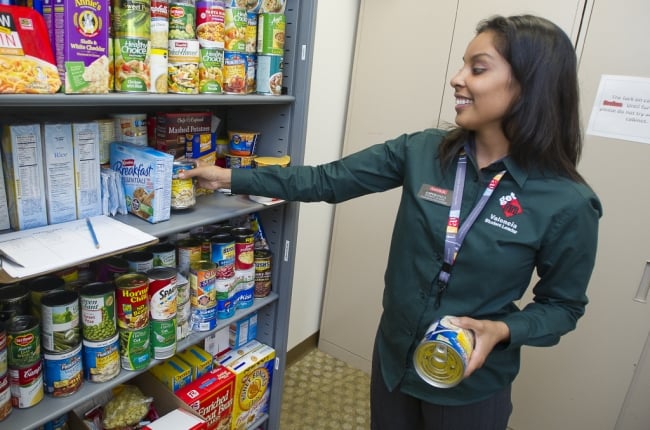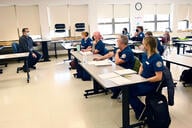You have /5 articles left.
Sign up for a free account or log in.

Valencia College
Community colleges that want students to graduate increasingly focus not just on academic needs, but on transportation, housing and food issues.
A report released today by the Wisconsin HOPE Lab and the Association of Community College Trustees reveals that many community college students are dealing with a lack of basic needs.
The report -- "Hungry and Homeless in College" -- surveyed more than 33,000 students at 70 two-year institutions in 24 states and found that two-thirds struggle with food insecurity, half are housing insecure, one-third are regularly hungry and 14 percent are homeless. The report defines food insecurity as the limited or uncertain availability of nutritionally adequate and safe foods, and homelessness as a person without a place to live or residing in a shelter, automobile or abandoned building.
“We have more detail and information, particularly about homelessness,” said Sara Goldrick-Rab, a professor of higher education policy and sociology at Temple University and the founder of the Wisconsin HOPE Lab. “These students do have financial aid and they are working and they’re still not able to make ends meet. It’s not like they’re lazy or sleeping a lot of the time. … What we see is a portrait of a group of people who are trying hard and still falling short.”
Goldrick-Rab said past surveys may be underestimating the number of students who are food and housing insecure because many of these students drop out in the first weeks of a new semester, however, for this survey researchers were able to reach students early.
The report found that there was very little variation in homelessness and hunger between community college students in urban, rural or suburban areas of the country. One-third of students who identified as food or housing insecure were both working and receiving financial aid.
Those students who identified as homeless were also more likely to work longer hours at their jobs.
“The profile of homeless students in particular shows they’re just as likely as other students to be working, but they’re less likely to be paid a real wage -- less likely to make $15 an hour,” Goldrick-Rab said. “Work doesn’t pay and college prices are too high and the cost of living is too high.”
As for those 28 percent of students surveyed who are also parents, 63 percent were food insecure, 14 percent were homeless, but only 5 percent received child-care assistance.
“One of the hardest things about serving people on the margins is finding them, and it’s becoming apparent these colleges have an opportunity to do some good here,” Goldrick-Rab said. “Now whether or not the college itself pays for it or the services are paid for by something external and located at the college is something to be worked out.”
There are a handful of colleges that are actively connecting low-income students to tuition, child-care assistance, food services and subsidized health insurance.
Amy Ellen Duke-Benfield, a senior policy analyst at the Center for Postsecondary and Economic Success, points to Cuyahoga Community College in Cleveland as an example of an institution that did its own analysis and found that many of its students were financially insecure. So the institution integrated access to public benefit services into its financial aid office, she said.
“We’re seeing an increasing number of colleges take that on across the country,” she said. “The fact is that Pell [Grants aren't] keeping up, state financial aid programs are insufficient, and the degree of institutional aid is either nonexistent or inadequate.”
Not every type of service has to happen at once, she said. In one region of Kentucky, which saw a high number of men who were laid off from work coming into the community college system, there was a stigma around accepting most public benefits. But those same men were happy to learn they qualified for subsidized child care.
Still, many college administrators and faculty members feel providing these services or opening access to them shouldn’t be the college’s responsibility, Duke-Benfield said.
“We can talk about reforming developmental education until we’re blue in the face and have the academic side of a college be a well-oiled machine that meets all the academic needs of students, but if we still have students who are hungry or housing insecure, you’re still going to have a completion issue,” Duke-Benfield said.
A recent report from the Center for Community College Student Engagement, for instance, revealed that nearly half of two-year students reported that a lack of finances could cause them to withdraw from their institutions.
And with the focus on performance and outcome-based funding, colleges no longer have the luxury of ignoring these issues, Duke-Benfield said.
There are a number of initiatives that colleges and nonprofit organizations are taking on their own to combat student hunger and homelessness, like the Working Students Success Network, which is run by Achieving the Dream and 19 colleges across the country and helps connect students to public benefits, financial education, job training and placement.
There’s also the College and University Food Bank Alliance, which has more than 450 institutions as members.
At Bunker Hill Community College in Boston, the institution is piloting a food voucher program that gives 100 low-income students $7 a day to purchase food from the institution’s cafeteria. The pilot program -- One Solid Meal -- is funded by donations.
“But this is a short-term solution,” said Pam Eddinger, president of Bunker Hill. “A longer-term solution would be some form of free lunch or some form of [food assistance] program that would help students in college, not only community colleges, but the four years as well.”
Eddinger, along with Achieving the Dream and the presidents of North Shore and Berkshire Community Colleges in Massachusetts, recently encouraged Senator Elizabeth Warren, along with Senators Edward Markey and Patty Murray, to request the U.S. Government Accountability Office conduct a national study of the issue.
Eddinger said it’s difficult for people to acknowledge the problem because hunger and poverty, especially among adults, is stigmatized.
“Everyone wants economic growth for our country and everyone wants a larger middle class, and one way to do it is through education,” she said. “If community colleges have 50 percent of all undergraduates, then that’s our solution.”




